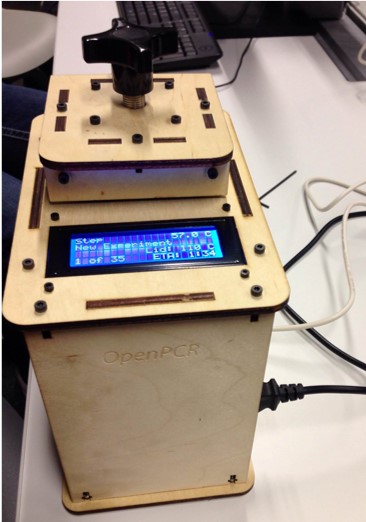BME100 f2013:W900 Group16 L4: Difference between revisions
Kevin Liao (talk | contribs) |
|||
| Line 15: | Line 15: | ||
|- valign="top" | |- valign="top" | ||
| [[Image:flower123.jpg|100px|thumb|Laura Stanovich | | [[Image:flower123.jpg|100px|thumb|Laura Stanovich | ||
Protocol Planning]] | Protocol Planning]] | ||
| [[Image:Butterfly123.jpg|100px|thumb|Aakriti Gupta | | [[Image:Butterfly123.jpg|100px|thumb|Aakriti Gupta | ||
Revision as of 10:59, 23 October 2013
| Home People Lab Write-Up 1 | Lab Write-Up 2 | Lab Write-Up 3 Lab Write-Up 4 | Lab Write-Up 5 | Lab Write-Up 6 Course Logistics For Instructors Photos Wiki Editing Help | ||||||
|
OUR TEAM
LAB 1 WRITE-UPInitial Machine TestingThe OpenPCR machine is a machine that amplifies specific sequences of DNA. The PCR process consists of three main steps which take a total of 1 minute and 30 seconds per cycle. These steps include denaturing, annealing, and extending. During the denaturing step, the machine is at a temperature of 95 degrees Celsius. This temperature causes the DNA to unwind and separate into two separate strands. Then, it the temperature decreases to 57 degrees Celsius in order to go through the annealing process. In this, the primers used to recognize a desired segment of base pairs and tell the DNA polymerase where to start adding base pairs attach to the DNA strands. After this, the temperature slightly increases to the temperature of 72 degrees Celsius. This step is called extending, and the Taq polymerase attaches to the DNA strands in order to build the complementary strand. This process can be ran in a selected number of cycles to produce a specific amount of DNA from a sample. Experimenting With the Connections When we unplugged part 3 from part 6, the machine turns on, but the LED display doesn't turn on. When we unplugged the white wire that connects part 6 to part 2, the white wire doesn't heat up the samples in the heating compartment.
This experiment began on 10-23-13 at 9:56 am. This ran until
(Write the date you first tested Open PCR and your experience(s) with the machine)
ProtocolsThermal Cycler Program
The PCR reaction mix consists of 8 tubes with 50 µL each of Taq DNA polymerase, MgCl2, and dNTP’s.
DNA/ primer mix The DNA/ primer mix consists of 8 tubes with 50 µL each of a different template DNA. All the tubes have the same forward primer and reverse primer.
Research and DevelopmentPCR - The Underlying Technology (Add a write-up, essay-style, organized into paragrpahs with descriptive headers, based on the Q&A's from Section three of your worksheet) (BONUS points: Use a program like Powerpoint, Word, Illustrator, Microsoft Paint, etc. to illustrate how primers bind to the cancer DNA template, and how Taq polymerases amplify the DNA. Screen-captures from the PCR video/ tutorial might be useful. Be sure to credit the sources if you borrow images.)
| ||||||







